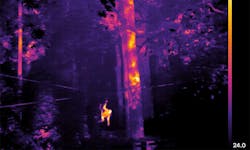Thermal imaging finds new applications in animal population monitoring
Scientists argue that we are losing the war on climate change; however, photonics is playing an important role in providing hope that technology can eventually solve the climate problems that are largely being ignored in this 21st century. In a collaboration between astrophysicists, conservationists, and ecologists that aims to save rare and endangered animals, drones fitted with thermal-imaging cameras are carrying out detailed monitoring of orangutan populations in Borneo.
Orangutans, like all great apes, build a sleeping nest in trees. Traditionally orangutan numbers are estimated by counting these nests from the ground. However, this method is costly and time consuming due to the large areas that need to be surveyed.
Drones can cover large areas of difficult ground quickly and monitor endangered wildlife from above. The addition of thermal-imaging cameras has even more benefits, as a new study shows: They can detect difficult to find animals at any time of day or night because of their heat signatures. The field team conducted 28 flights at two sites over six days and successfully spotted 41 orangutans from the air, all of which were confirmed by ground observers.
By combining drone technology with thermal-imaging cameras, which are usually used by astronomers, researchers were able to spot and classify the animals' heat signatures. To distinguish the primates from their surroundings, they performed flights before 9 am or after 7 pm local time.
Claire Burke, an astro-ecologist at the university, who will present the findings at the 'Unifying Tropical Ecology' conference in Edinburgh, said, "We tested the technology on orangutans in the dense tropical rainforest of Sabah in Malaysia. In thermal images, animals shine in a similar way to stars and galaxies, so we used techniques from astronomy to detect and distinguish them. We were not sure at all whether this would work, but with the thermal-infrared camera we could see the orangutans quite clearly because of their body heat, even during fog or at night."
This innovative technology could potentially be used to understand and monitor population numbers of orangutans or other endangered primate species.
Nicola Loweth, Asian Programme Manager at WWF, who was on the Bornean study, said, "As ever more species are decimated, due to human activity such as deforestation, we must embrace and scale up innovative approaches to monitoring wildlife populations, to better protect them for generations to come. Our collaboration with Liverpool John Moores University to test the feasibility of thermal-imaging and drone technology to monitor orangutan populations in Sabah has proven promising and could have a wide range of applications, benefiting wildlife conservation as a whole."
The team also spotted a troop of proboscis monkeys during the field trial, which they were able to distinguish from orangutans based on their smaller size. Besides that, proboscis monkeys are generally found in groups, whereas orangutans tend to be solitary or in pairs. Pygmy elephants were also captured on a night-time forage through an oil palm plantation.
The astro-ecologists are now developing a machine learning algorithm to tell animal species apart, based on their unique thermal fingerprint.
"In the future, we hope to be able to track, distinguish and monitor large numbers of different species of animals in real time, all around the globe, so that this technology can be used to make a real impact on conservation and stop poaching before it happens," Burke concluded.
The group previously tested the technology with spider monkeys in Mexico and riverine rabbits in South Africa and will soon be embarking on a field study with the Lac Alaotra bamboo lemurs in Madagascar.
This research is funded in part by the UK's Science and Technology Facilities Council (part of UK Research and Innovation), WWF-UK and Global Challenges Research Fund grant ST/R002673/1 (PIs S. Longmore & S. Wich); the project will be featured in the BBC Two 'Equator from the Air' series in Spring 2019.
SOURCE: Liverpool John Moores University; https://www.ljmu.ac.uk/about-us/news/articles/2019/4/10/astro-ecology-counting-orangutans-using-star-spotting-technology
About the Author

Gail Overton
Senior Editor (2004-2020)
Gail has more than 30 years of engineering, marketing, product management, and editorial experience in the photonics and optical communications industry. Before joining the staff at Laser Focus World in 2004, she held many product management and product marketing roles in the fiber-optics industry, most notably at Hughes (El Segundo, CA), GTE Labs (Waltham, MA), Corning (Corning, NY), Photon Kinetics (Beaverton, OR), and Newport Corporation (Irvine, CA). During her marketing career, Gail published articles in WDM Solutions and Sensors magazine and traveled internationally to conduct product and sales training. Gail received her BS degree in physics, with an emphasis in optics, from San Diego State University in San Diego, CA in May 1986.
